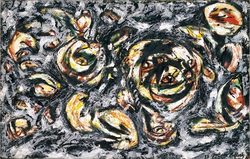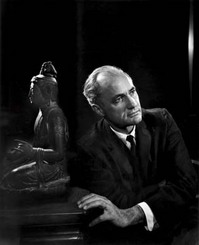A recent trip to the Guggenheim got me thinking about one organizing principle for exhibitions that’s seems to be going around — showing works acquired by, or during the term of, a museum’s director. The trend seems to stem both from happenstance and anniversary-marking. The Metropolitan Museum honored Philippe de Montebello on his retirement; the Philadelphia Museum of Art honored Anne d’Harnoncourt soon after her sudden, unexpected death. The Cleveland Museum of Art recently opened an exhibition honored its legendary former director, Sherman Lee, who died last year. And the Guggenheim, which just turned 50,
 is showing The Sweeney Decade:Acquisitions at the 1959 Inaugural.
is showing The Sweeney Decade:Acquisitions at the 1959 Inaugural.
Sometimes, this idea clearly does not work — at the Guggenheim, for example. The Sweeney show simply doesn’t shine. James Johnson Sweeney, who headed the museum from 1952 to 1960, acquired many works by artists whose names are well-known today: Jackson Pollock (that’s his Ocean Greyness, 1953, at right), Willem de Kooning, Eduardo Chillida, Antoni Tapies, William Baziotes and Hans Hartung, among them. The press release suggests he bought works by artists “whose work emphasized the emotional aspect of abstraction.” That wasn’t apparent to me. The works are boring, the reviews have been mixed, and the Frank Lloyd Wright exhibition nearby seemed to me to be generating more interest.
But it’s not just the works that matter. I liked the way the de Montebello exhibition was organized — chronologically, according to the year they were acquired. That meant works of all styles were shown side-by-side, which is a great way to train your eye. But curators at the Met have told me that the public did not like the show.
They wanted a narrative, and there was none.
In Philadelphia, the d’Harnoncourt show wasn’t really a show — works acquired during her tenure were simply given a special label. It was more of a tribute, hastily organized because her dealth was so unexpected. Visitors to the permanent collection may or may not have noticed the labels, but I did — and I imagine other people who knew Anne did too.
 I haven’t seen the Cleveland show, Streams and Mountains Without End: Asian Art and the Legacy of Sherman E. Lee at the Cleveland Museum of Art. Like Anne, Lee was very much appreciated at his museum — in his case, for making it a world-class institution. Steven Litt, critic at the Cleveland Plain Dealer, said in his review:
I haven’t seen the Cleveland show, Streams and Mountains Without End: Asian Art and the Legacy of Sherman E. Lee at the Cleveland Museum of Art. Like Anne, Lee was very much appreciated at his museum — in his case, for making it a world-class institution. Steven Litt, critic at the Cleveland Plain Dealer, said in his review:
…the show reveals Lee as a collector with an eye for artworks saturated with eroticism, pathos, religious ecstasy and raunchy humor.
Lest anyone miss the point, the show’s organizers — Anita Chung, curator of Chinese art at the Cleveland museum; Stan Czuma, curator emeritus of Indian and Southeast Asian art; and Jim Ulak, deputy director of the Freer and Sackler galleries — included a high number of zingers among the 50 objects on view.
That one sounds like a winner. Too bad it ends on Aug. 23. Here’s a link to the rest of Litt’s review.
I’ve got nothing against honoring a director; but the idea has limitations. Even when the art is great, as at the Met, it may not be the best way to engage the public.
Photo Credits: Courtesy of Guggenheim Museum (top), Cleveland Museum of Art (bottom)
